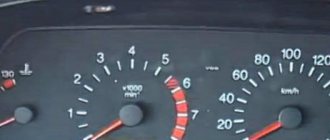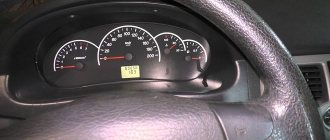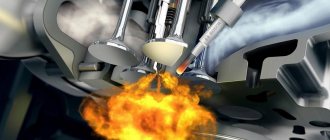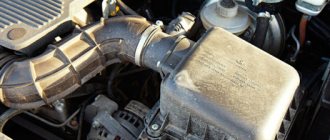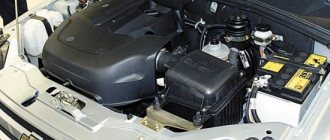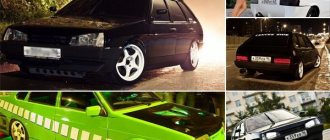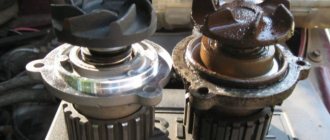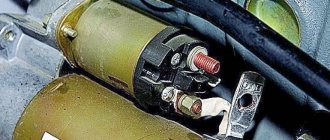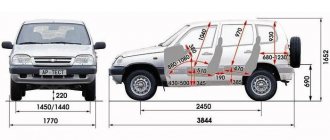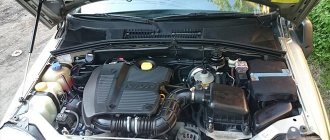What to do if the engine doesn’t start well when it’s hot?
Note that the symptoms of problematic engine starting manifest themselves in different ways. Some cars refuse to start at all until the power plant has completely cooled down. Others start on the third or fourth try, and some motors have to be cranked for 20-30 seconds to fully start.
What to do in this case? You need to look for the problem and fix the malfunction, replace a poorly functioning internal combustion engine element or repair it. Note that such a malfunction may be a harbinger of more serious breakdowns, so it is better to solve it at an early stage.
Bad fuel as a possible problem
When you fill up with low-quality gasoline or diesel fuel, you shouldn’t be surprised why the engine doesn’t start well when it’s hot. Fuel is the most common cause of poor engine starting. This is easy to check. Just remove all the fuel and fill it with new, better quality. If you previously refueled with A92 gasoline, then you can try filling it with A98 and see how the car behaves. In the case of diesel fuel, you need to change the gas station and choose a more reliable seller.
The following problems may occur with the motor:
- There is a high content of additives in the fuel, which are poorly accepted by the engine.
- It is difficult for the pump to pump the required volume of fuel due to clogged filters.
- Engine control settings are lost. Inaccurate operation of the air mixture supply is also possible.
- The idle air valve and mass air flow sensor may be the culprit.
- Features of the operation of carburetor engines. If they are too hot, they have trouble starting.
The last point does not apply to injection engines. It’s just that carburetor engines have such a feature that they don’t start well when hot. This is due to the fact that the carburetor heats up to a very high temperature. Gasoline evaporates under the influence of temperature and fills the carburetor chambers and tubes as gas. In this case, the float chamber remains empty. And if you start the engine 5 minutes after stopping the engine, you may encounter a problem starting it, because... there will be no liquid fuel in the combustion chambers. This is normal, and this problem can be solved either by manually pumping fuel or by several attempts to start the engine. In injection power plants, this problem is eliminated, because there the fuel is delivered to the combustion chambers directly from the main line.
Fuel pump problem
The fuel pump in a car does not have special cooling. It is located in the tank and is cooled by gasoline, and if there is little gasoline in the tank, the pump may overheat. Therefore, it is not recommended to drive while the “Refueling” light is on. Also, in hot weather, the gasoline in the tank heats up, as does the fuel pump during operation. All together, this leads to the fact that during the process of pumping gasoline, the pump gets very hot and refuses to start until it cools down. In this case, the pump may refuse to work even while driving: it simply stalls. If the engine does not start well when hot due to the pump, then the experts recommend:
- Replace it. This is a simple and correct solution. The cost of the pump is small - about 1000 rubles. You will also have to pay 500 rubles to replace it.
- Allow the pump to cool and try to start the engine again.
Problem with DPKV
Another common element that affects hot starting of the engine is the crankshaft position sensor (CPS). Quite often it refuses to work when the engine temperature rises. This is one of the elements without which the operation of the entire system is generally impossible. After replacing the DPKV, everything returns to normal for many car owners. Therefore, when your VAZ car has difficulty starting when hot, it makes sense to try replacing this sensor. It costs a penny (a new one is around 500-600 rubles, although you can look for a used one). You can even make the replacement yourself, you just need to know where it is and have screwdrivers on hand. Finding out its location on each car is not a problem - all the information is on the Internet.
Problem starting on gas
HBO has settled under the hoods of many cars. This system allows you to save a lot, but at the same time it is quite capricious. If your engine runs on gas, and after a short period of inactivity there are problems with starting, then it is better to contact a service station. The reasons why the engine is difficult to start when hot can be different. We cannot exclude a situation where the expansion of gas in the tank created additional pressure, causing the ratio of gas and air mixture to change. This may be the reason for poor engine starting when hot. The same crankshaft position sensor also cannot be ruled out. It may not work well regardless of whether the engine is running on gas or gasoline.
Chevrolet Niva does not start: three different sensors
The crankshaft position sensor will not indicate its failure in any way. The Check light will not light up, the engine will simply not start. Finding this sensor is easy if you know where the alternator belt is (see photo).
DPKV sensor connector
Here we check the serviceability of the wiring, as well as the distance from the sensor to the “teeth” (0.8-1.2 mm).
The second suspicious element will be the temperature sensor. The engine may not start only if it breaks. In this case, the electric fan should work without turning off. That is, a break in the DTOZH sensor circuit is easily recognized.
Element “6” is DTOZH
In the photo there is a sensor, and to get to it, the air duct is removed.
If the idle speed control malfunctions, the engine on a Chevrolet Niva does not start, but the starter turns. By the way, the Check lamp may be on. Diagnostics:
- Just lightly press the gas and turn on the starter;
- If the engine starts, but without gas it does not start, it means the IAC is faulty.
Carburetor problem
Most often, cars with a carburetor suffer from problems starting when hot. This happens due to the design features of the unit. The main reason here is overheating.
During operation, the carburetor is cooled by the external environment - air and fuel fluid that pass through its structure. While the engine is running, the carburetor is still cooling, so everything is fine. As soon as the engine is turned off, the flow of air and fuel to create the air-fuel mixture stops. Where does overheating come from? The fact is that the engine is still hot, which is why the carburetor temperature also increases. The gasoline that remains in the carburetor chamber begins to evaporate with a constant increase in temperature.
Gasoline vapors penetrate all channels that are connected to the float chamber, causing plugs to form.
The carburetor, air filter, and fuel lines become clogged. Since the channels through which fuel flows become clogged, the fuel level drops to insufficient to start the engine.
For different car models with a carburetor, this problem may have its own character, so the severity of each individual case will be different. In some cases, the engine can be resumed after several test runs. When the jams in the system disappear, the engine will start working again. Sometimes attempts can take up to half an hour, after which the car will still be running. Manual pumping of fuel helps with the problem perfectly.
This problem is typical only for cars with a carburetor.
Why does the Chevrolet Niva start and immediately stall when it’s cold?
The Chevrolet Niva received an injection engine that was progressive for those times, and with it a whole list of injection problems. The fact is that any engine with an injection power system is controlled 90% by electronics - sensors, controllers, processors. And these elements require a very high-quality elementary base, fine tuning and special care during assembly. If a Chevrolet Niva starts and stalls when cold, there is a possibility that the control electronics system has failed.
Injector problems
Why doesn’t the car start when it’s hot if, for example, it has an injection engine? There are also a lot of problems with such cars, mainly due to sensors, but there are also other problems. There are several options here:
- Coolant sensor malfunction. Since the injection system is almost completely automated, its operation depends on the readings of sensors located in the gas tank, engine and other components. As soon as the reading device produces incorrect information, the entire system begins to malfunction. For example, problems in the readings of the coolant sensor lead to the fact that the ECU, which reads the device information, gives the wrong command to other operating elements. As a result, the wrong amount of fuel enters the chamber, which is why it is impossible to create a combustible mixture. The solution to the problem is to disconnect the sensor, clean it, or replace it if it is damaged.
- Problems with injectors. This is an extremely rare case of malfunction, but it does happen. The breakdown consists of a breakdown of the injector, and for this reason fuel is not supplied. The lack of pressure inside the channel leads to the fact that fuel does not enter the combustion chamber. The injectors need to be replaced.
- Faulty air flow sensor. As in the first case, it can easily fail, which disrupts the operation of the system for creating a combustible mixture. As a result, the fuel is either too rich in oxygen, or, conversely, poor. In both cases, fire does not occur, and therefore the engine does not start. The following symptoms accompany the problem: surges in engine power, strange sounds when starting the engine, the sound of a strong exhaust from the gas exhaust system, failures when pressing the gas. Replacing the device and adjusting the entire system should help.
Problems of domestic cars
Many domestically produced cars also have trouble starting when the engine is hot. The problem is in the design, but this time the gas tank. The fuel pump, which heats up during operation, should, in theory, cool down a little during operation. This occurs due to the liquid that moves through its body. During the summer heat, the liquid heats up, so cooling does not occur, which leads to disastrous consequences.
A faulty high-pressure fuel pump (HPF) stops working, which leads to a disruption in the fuel supply to the engine. Subsequent turns of the key and pushes will not help, but there are several “old-fashioned” methods. The device needs to cool down.
- Wet a cloth in cold water and apply it to the fuel pump housing until it cools down.
- Roll the car to a cool, sheltered place from the sun, open the hood. Wait a while for the unit to cool down. This usually takes 15–20 minutes.
An overheated fuel pump breaks down completely and cooling will not help it, so if after some time the car still does not start, you will have to replace the part. If the engine still starts when cold, then the problem is in the turbocharger.
It is recommended to replace the device, otherwise the problem will recur every few days.
A warm engine may not start due to poor quality fuel or the presence of unacceptable additives. This happens after changing the fuel. At the first start, everything may be in order, but then the engine stalls and does not want to start.
Checking this option is quite simple - cool the car. If you subsequently start it cold and hear extraneous sounds from the engine, most likely the problem is in the fuel. The engine does not start for other reasons:
- The presence of components in the fuel that do not allow the creation of a combustible mixture. In different cases the effect may be different, sometimes there is not enough spark to ignite, sometimes more air is required for ignition. Small inclusions also prevent the engine from starting.
- The fuel filter is clogged, which is why the pump cannot supply fuel. In such cases, thick smoke comes from the gas outlet. You need to remove the filter, clean it and put it back.
Doesn't start well when cold - Chevrolet Niva Forum
This basis is primary for all types of cars.
Niva Chevrolet. It wouldn't start in the morning.
Starter Check the starter contacts and tighten them. This may not only be the fault of the driver, because there is a possibility of a breakdown of the fuel level sensor. Yes, I know this method, but when it was necessary, of course I forgot about it:
The battery spins vigorously, but does not catch on for a long time, and sometimes it doesn’t work at all the first time...
There is no fuel in the gas tank. I went to Brisk for 3 years and had no problems.
Finding out the reason why your iron horse does not want to work is done with the help of your eyes, ears and car tips. But this is the question that interests everyone: If necessary, adjust the float.
The spark plugs may be faulty, the gap may be incorrect, etc.
Starting Shnivy (Chevrolet Niva) in the cold.
The number of reasons why the Chevrolet Niva does not start, but the starter turns, has increased to 7. And then the system produces sound signals.
Well, the APS-6 unit cannot be turned off. Usually you have to flash the ECM. There is no need to panic right away: Fuel rail On the ramp, next to regulator 5, there is a control fitting 3. It is closed with a cap, which is unscrewed, and then carefully pressed on the spool. Drawing of the ramp If fuel flows, it means it is entering the ramp. But perhaps the necessary pressure is not created.
Not every driver counts fuel by the number of kilometers driven. Clogging of the fuel filter or fuel pump, which leads to breakdown of the latter.
HBO for cars
A hot engine can also cause a breakdown in the case of an installed gas system. Since driving on gas has recently become profitable, many drivers switched to this type of fuel, however, they did not take into account some of the nuances of the new system. In hot weather, gas expands more, which leads to increased pressure inside the system and often causes damage. This is why it is bad to drive on gas in the heat.
At high temperatures, seals and hoses can fly off, which leads to gas leakage.
The result is an extremely dangerous situation. To avoid this, try not to fill the tank to full gas in the summer, this will reduce the pressure in the system and the risk of breakdown. If a similar problem occurs, it is recommended to let the car cool down and then visit a service station. You should not repair the gas system yourself; the equipment should be adjusted by a specialist.
Reasons why Chevrolet Niva doesn't start well
To troubleshoot a car problem, you first need to find out the source why the car won’t start. The driver can be helped in identifying damage by various sensors on the instrument panel, an external inspection of the car, or the sound that is made when the key is turned. So, the main problems that cause the engine to start poorly and the car will not start may be the following malfunctions.
Causes of electrical damage:
- The car battery has become unusable or discharged. This basis is primary for all types of cars.
- The starter became unusable due to getting wet, or, as they say, it served its purpose.
- Poor contact from the battery due to oxidation of the terminals.
- Defective spark plugs, which could occur in the following cases:
- Poor quality fuel, which led to them getting wet.
- The spark plugs have already worn out and a large gap has formed.
- The fuse has blown.
- The ignition relay or something else has failed.
- The wire supplying the main components of the car (for example, power supply to the starter or injector) has come off.
- The immobilizer does not work. If for any reason the anti-theft system does not work, the car will not be able to start until the immobilizer malfunction problem is resolved.
Mechanical faults:
- There is no fuel in the gas tank. This may not only be the fault of the driver, because there is a possibility of a breakdown of the fuel level sensor. Not every driver counts fuel by the number of kilometers driven.
- Clogging of the fuel filter or fuel pump, which leads to breakdown of the latter.
- Nozzle clogged.
- Insufficient oil level in the engine or antifreeze in the radiator. Causes the engine to overheat.
- The idle speed control is damaged.
How to find out the cause of the problem
Knowing the most common sources for which the Chevrolet Niva does not start well, now you need to find out how to correctly determine the damage? After all, there are many reasons, and it will take a considerable amount of time to check all this. Finding out the reason why your iron horse does not want to work is done with the help of your eyes, ears and car tips. You can call a technician to your home, who will determine the damage in a matter of minutes, and sometimes even seconds. And for this clarification, you will have to pay a lot of money. You can take your car to a service station by asking a friend to help with transportation. It will cost much less than calling a technician to your home, but you will spend a lot of time. Therefore, your best bet for determining damage is you and your head. Only if all possible reasons have been verified, then it is necessary to contact a specialist. Perhaps your car requires a major check of the entire system.
What else is worth checking?
Other problems that may hinder hot-starting cars include:
- The main injector temperature sensor is broken. This problem only occurs in diesel engines.
- The pump drive is stretched, causing fuel injection to occur incorrectly and the combustible mixture does not meet the required characteristics. You can correct the injection yourself.
- The membrane in the fuel pressure regulator has broken. You need to check the membrane; if it is damaged, replace it.
- There may also be problems with sensors: idle speed, pressure in the fuel lines, crankshaft position or check valve in the fuel pump.
Chevrolet Niva starts and stalls when cold, what should I do?
Perhaps the reason should be looked under the hood?
After a long period of parking, the engine starts, runs for a few seconds, and then stalls. There may be several reasons for such a malfunction, but let’s imagine that the diagnostic station is 300 km away from us, and we need to find the cause. We proceed as follows.
Looking at the candles
When using spark plugs with cracks, current leaks through the insulator to the spark plug body.
We unscrew the spark plugs and assess their condition.
If the spark plugs are flooded or wet, then there is a possibility that the idle speed sensor did not turn on, the throttle unit sent the wrong signal to the ECU, which in turn sent too much fuel through the injectors.
In addition, a common culprit for a malfunction with such symptoms is the throttle position sensor. With a high degree of probability, the spark plugs could fail.
Listening to the fuel pump
Niva Chevrolet fuel pump under the seat.
Turn on the ignition and listen to see if the fuel pump is working.
There is a possibility that fuel is not supplied to the ramp, and the engine flared only due to the remaining gasoline in the fuel line.
If this version is confirmed, then the engine will no longer start, the fuel pump needs to be repaired, the fine filter or mesh, or the coarse filter on the fuel pump itself must be replaced.
Looking for an air leak
You should look for air leaks under the hood.
Air leaks in the power system can also cause a similar malfunction. A mixture that is too lean at startup will prevent the engine from running after a flash.
To verify this in field or garage conditions, just cover the air intake pipe of the air filter.
Often, air leaks can occur between the filter housing and the throttle assembly; sometimes excess air can enter through the junction of the intake manifold and the block head.
Cleaning the XX regulator
Old idle air control on a Niva Chevrolet.
Idle speed regulator . Considering the quality of our 92 gasoline, dirty IAC is not that uncommon.
If, after trying to start again, the car starts, but the speed fluctuates within the range of 1500–2000 rpm, you can safely remove the idle speed control, clean it or change it.
The regulator will also manifest itself in motion, when the car is coasting, the engine may stall or stall frequently, there may be no idle speed at all if the regulator is faulty or completely coked.
